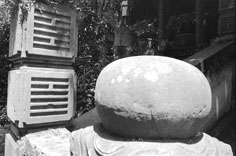

Candida - The Yeasty Beastie
Having Candida, or yeast, overgrowth has become something of a fad over the past decade. It seems that just about every symptom known to man can be attributed to the little bugger’s wily ways. While it is my belief that too many people cry “Yeast!”, it is also true that many people do have a problem with yeast overgrowth that, if not managed properly, will haunt them for a very long time. It should be noted that while this article will deal primarily with intestinal yeast overgrowth, most of the information will apply to vaginal infections as well.
People who have yeast overgrowth respond to it in many different ways. Some describe a “feel sick all over” syndrome while others experience fatigue, allergies, immune system malfunctions, depression, chemical sensitivities, and digestive disturbances (just to name a few!). The symptoms are most likely due to the large amount of toxins and antigens that the yeast produce. Women are eight times more likely to have a yeast overgrowth condition. This is due to the effects of estrogen, prior use of birth control pills (especially if for longer than two years), and a higher use of antibiotics. Some other predisposing factors include: Diabetes, Cortisone and prednisone use, impaired liver function, altered bowel flora and, or course, a poor diet. Diets high in sugar, white flour and dairy products tend to be the most likely to contribute to a yeast overgrowth.
So how do you know if you got it? The process should start with a detailed history taken by a good medical clinician. This should then be followed up with a stool analysis - looking for the presence of the yeasts themselves. The combination of these diagnostic tools should be sufficient to decide if anti-fungal treatment is warranted. If still not satisfied, one can also look for antibodies to certain yeasts in the blood.
Therapeutic considerations when dealing with a yeast overgrowth are as varied as the possible symptoms that one might have. While there are many different options out there, a few have been proven to work better than others. I must say that any plan which focuses solely on eradication of the organisms is destined to fail because in order for a true change, one must address the underlying factors which allowed the overgrowth in the first place. However, that being said, eradication is an essential part of any plan, especially if you want to feel better faster.
• Certain herbs are known to be effective fungicides (yeast killers). These are: Garlic, Gentian, Tumeric, Goldenseal, Coptis, Inula, St. John’s Wort, myrrh, black walnut, and Licorice root (among others).
• Other natural anti-yeast agents include: Oregano Oil (must be enteric-coated), Citrus Seed Extract, high-sulfur vegetables (in large amounts), undecylinic acid, and probiotics (Acidophilus).
• A Candida control diet is also essential. This consists of eliminating all refined sugars, dairy products, simple carbohydrates, and foods with high yeast contents such as alcoholic beverages, cheeses, dried fruits, melons and peanuts.
• Furthermore, a high potency multi vit./min. should be taken along with other immune supportive therapies. Also, elimination should be optimized, perhaps with the use of a fiber supplement.
• A Special yeast called Saccharomyces boulardi is known to be able to “crowd out” Candida in the intestines. It also is able to inhibit Candida from escaping the gut and entering the blood stream, which can cause much more serious problems.
• And, of course, any contributing stress or emotional issues which may be play must be dealt with before a true resolution is seen.
Some other interesting facts:
- Prednisone use has been shown to enhance the ability of Candida to translocate to the spleen, liver and kidneys.
- Completely resistant Candida strains have started appearing. This is not a good thing.
- Low stomach acid or pancreatic enzyme output will allow Candida overgrowth in the small intestine.
- Amalgam (Mercury) toxicity can sometimes mimic a Candida infection.
- Low zinc status and high iron status were both correlated with more frequent vaginal yeast infections.
- Women with recurrent yeast infections will very likely have an overgrowth in their gut which will continuously repopulate the genital area.
If you have a yeast overgrowth and are determined to handle it naturally, then I hope some of this information was helpful. Remember - you must identify and correct the underlying imbalance that allowed this situation to occur. It is also very important to stick to the diet outlined above. As far as eradication goes, it is my experience that people tend to take too small a dose for too short a time for it to be totally effective. You should work with a health care practitioner who knows the proper amounts in order to assure you are taking enough, and especially, that you are not taking too much. This article only covered a small amount of all possible therapies. Working with a trained practitioner will also expose you to all of the options available. Whatever you do, Good Luck! Be persistent and optimistic and you will succeed.
|
Copyright © 2006 DrStadtmauer.com (excluding copy imported from other sites)
Site operated, built, and maintained by Dr. Stadtmauer |
||||||||||||